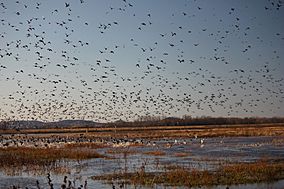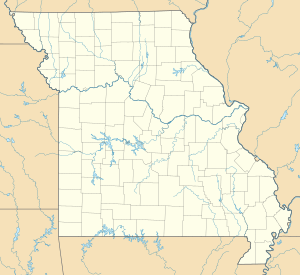Clarence Cannon National Wildlife Refuge facts for kids
Quick facts for kids Clarence Cannon National Wildlife Refuge |
|
|---|---|
|
IUCN Category IV (Habitat/Species Management Area)
|
|

Fall migration, Clarence Cannon National Wildlife Refuge, November 2011
|
|
| Location | Pike County, Missouri, United States |
| Nearest city | Annada, Missouri |
| Area | 3,750 acres (15.2 km2) |
| Established | 1964 |
| Governing body | U.S. Fish and Wildlife Service |
| Website | Clarence Cannon National Wildlife Refuge |
The 3,750-acre (15.2 km2) Clarence Cannon National Wildlife Refuge is a huge natural area in Pike County, Missouri. It sits right next to the Mississippi River in a flat, low area called a floodplain. This refuge is a safe home for many different kinds of birds, including waterfowl (like ducks and geese), wading birds, shorebirds, and songbirds. Even though a protective wall called a levee keeps the main part of the refuge safe, it also helps store extra water when the river floods.
Contents
What is a Wildlife Refuge?
A national wildlife refuge is a special place. It is set aside to protect wild animals and their homes. These areas help make sure that different species have a safe place to live. They also help keep nature healthy. The United States Fish and Wildlife Service manages these refuges. They work to protect wildlife for everyone to enjoy.
Why is Clarence Cannon Important?
Clarence Cannon National Wildlife Refuge is very important. It is located in the Mississippi River floodplain. This area is a key stop for birds migrating (traveling) long distances. Birds need safe places to rest and find food during their journeys. The refuge provides these vital resources. It helps many bird populations thrive.
A Home for Many Birds
The refuge has many different types of natural areas. These include wetlands, forests, and open fields. Each type of area attracts different kinds of birds.
- Waterfowl: You might see ducks, geese, and swans here. They love the water and marshy areas.
- Wading Birds: Birds like herons and egrets have long legs. They walk in shallow water to find food.
- Shorebirds: These birds, such as sandpipers, search for food along the muddy edges of ponds.
- Songbirds: Many small, colorful birds live in the trees and bushes. They fill the air with their songs.
How the Refuge Helps with Floods
The refuge is in a floodplain. This means it can get flooded when the Mississippi River rises. A large levee protects most of the refuge land. However, the refuge also has areas designed to hold extra water. This helps reduce flooding in nearby towns. It acts like a giant sponge, soaking up excess water. This natural flood control is very helpful for the whole region.
Who Manages the Refuge?
The Clarence Cannon National Wildlife Refuge is part of a bigger system. It is managed by the Great River National Wildlife Refuge. This refuge is part of the Mark Twain National Wildlife Refuge Complex. The United States Fish and Wildlife Service oversees all of these areas. Their job is to protect and manage wildlife and their habitats. They make sure the refuge stays a safe place for animals. They also help people learn about nature.



